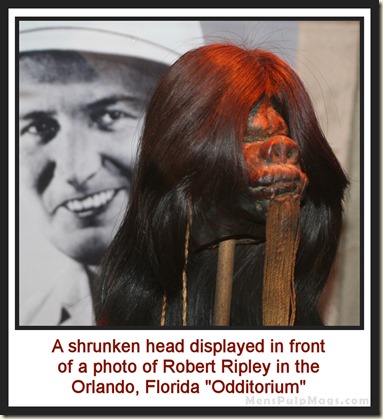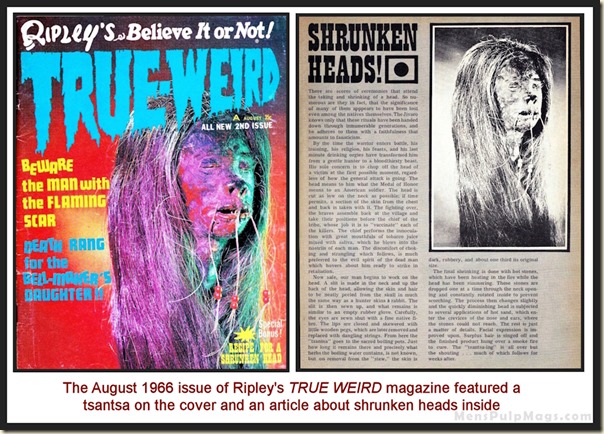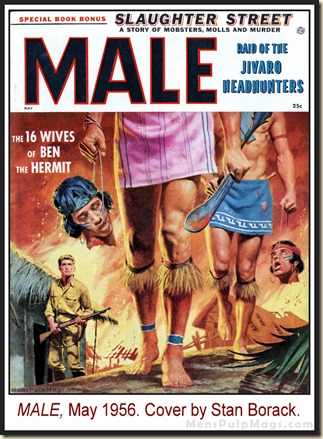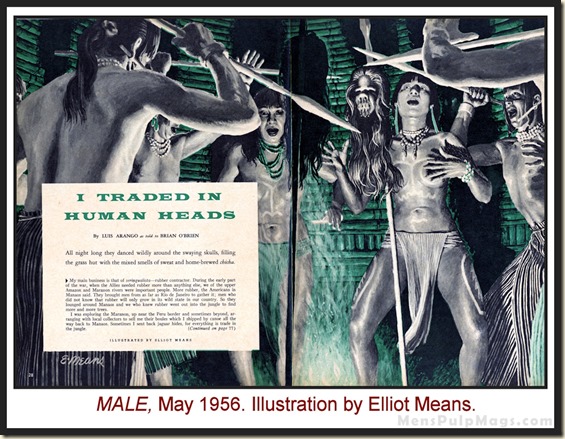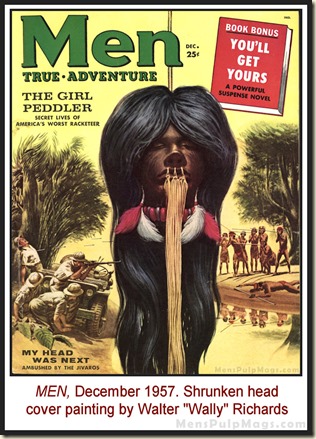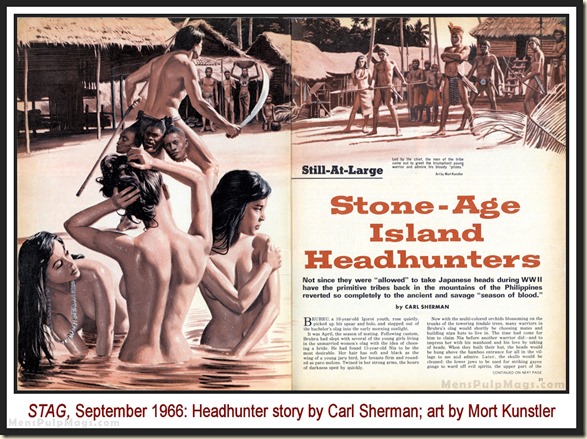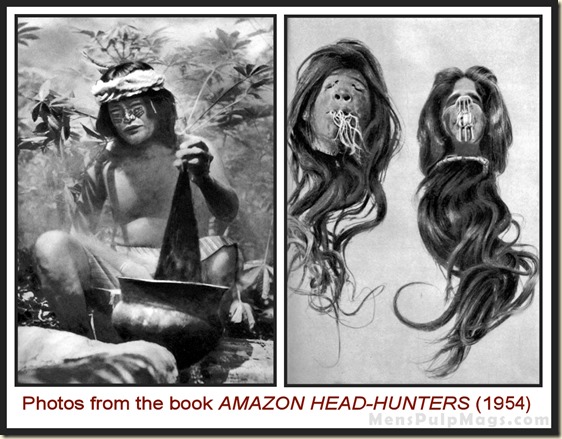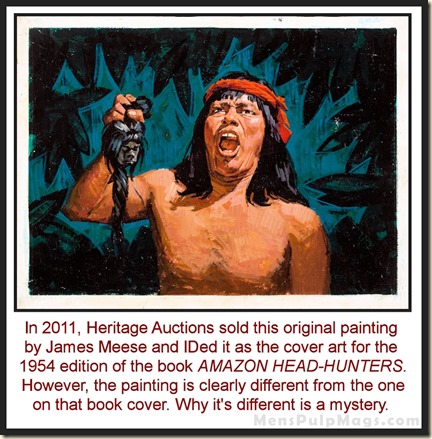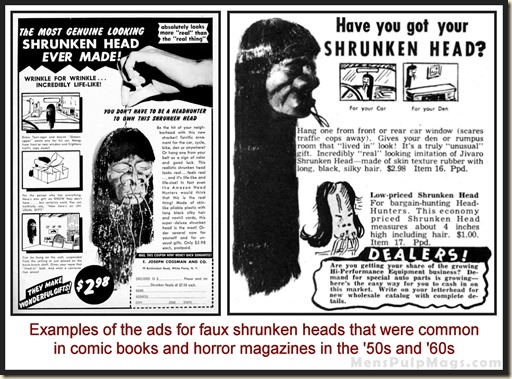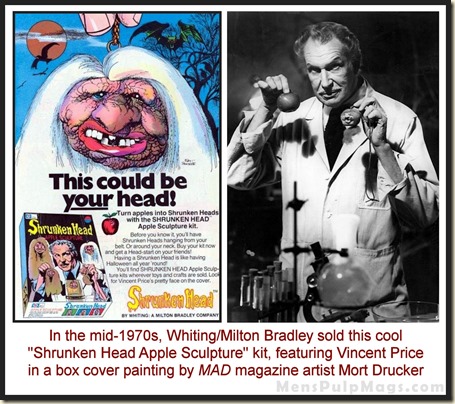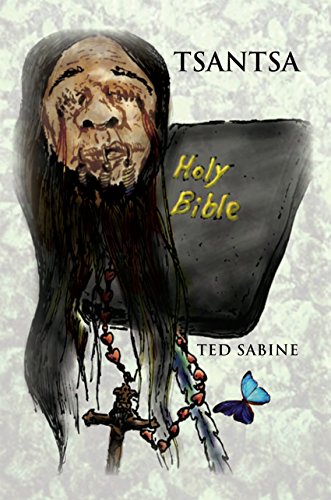
EDITOR’S NOTE: John Navroth has an encyclopedic knowledge of just about everything related to monsters and horror. On his long-running, award-winning blog, MONSTER MAGAZINE WORLD, his main focus is on vintage monster and horror magazines. But, as I’ve found from being an avid reader of that blog, John’s posts are wide-ranging and often touch on many related genres, from movies and novels to model kits and men’s adventure magazines. After John posted insightful reviews of several books in our Men’s Adventure Library book series that collect stories about monsters and killer creatures, we started an email discussion about our areas of mutual interest. In one exchange, John told me had once written an article about shrunken heads that mentioned the role men’s adventure magazines played in popularizing them in American culture in the 1950s and 1960s. I asked him if I could post that article here on my blog and he said “yes.” John had cool images to use for the post but didn’t have access to some of the MAM issues he mentioned. Luckily, I have them in my collection. So, I made scans of the covers and spreads and the result is below, in John Navroth’s first, and hopefully not last, guest post on MensPulpMags.com, “WHEN SHRUNKEN HEADS WERE BIG!”
* * * * * *
For a time, you could see them hanging in just about every hot rod or roadster that cruised the streets.
Strung from rear-view mirrors, radio knobs or anything else that stuck out from the dashboard, they were a totem, a fetish, a collective counterculture howl of unconscious teenage angst. You’re probably thinking foam dice, right? Wrong.
We’re talking shrunken heads, Daddy-O!
Originally a war trophy and religious ornament of certain indigenous South American peoples, shrunken heads, or tsantsas as they are called in their native culture, they later became a curio, then a pop culture phenomenon to a generation of novelty-starved baby-boomers.
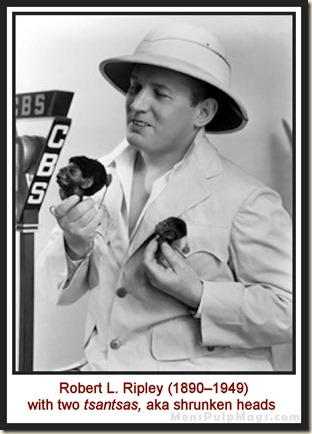 Along with the aforementioned foam dice, Rat Fink decals, bobble-hipped hula gals and other wild and crazy ornamentation of (mainly) Southern California car culture, shrunken heads – or their rubber and plastic counterparts, anyway – were appropriated for use as another kind of symbol – that of the rebellious and untamed youth of the ‘50s and ‘60s.
Along with the aforementioned foam dice, Rat Fink decals, bobble-hipped hula gals and other wild and crazy ornamentation of (mainly) Southern California car culture, shrunken heads – or their rubber and plastic counterparts, anyway – were appropriated for use as another kind of symbol – that of the rebellious and untamed youth of the ‘50s and ‘60s.
How did these repulsive and downright morbid things ever become so popular?
It’s hard to say exactly, but like many odd and curious objects, they wound their way into the fabric of American society that, at the time, was thirsty for the exotic – not just the thirst for alcoholic drinks like Mai Tai’s and Zombie’s – but all manner of imported cultural kitsch from the islands to the jungles, anything that would help extend the dream of a never-ending Tiki party that celebrated the great post-war surge of American industry and wealth, all with Martin Denny, Arthur Lyman, or Les Baxter wax spinning on the turntable.
So, who do we have to thank for this oddball phenomenon?
The person that most likely popularized shrunken heads in the “civilized” world was a man by the name of Robert Ripley.
Born in 1890, Ripley became a paid professional cartoonist at the young age of 14. A year later he found regular work at the San Francisco Chronicle drawing sports cartoons.
Then he came up with an idea for a one-panel series that featured odd and unusual facts on just about anything under the sun, including those sent in by his growing readership.
This series eventually became known as the famous “Ripley’s Believe It or Not” cartoon.
Ripley was possessed of a wanderlust that took him on his first trip around the world in 1922, during which time he collected many curios and artifacts from the countries he visited.
He became especially fond of Asian culture, even going so far as to sign his cartoons, “Rip Li” for a time.
At one point, he found himself in South America.
Soon after he returned, the world was shocked and amazed to see photos of Ripley holding a bizarre . . . shrunken head in his hand, showing him gazing at it with a rapt fascination that was shared by anyone else who dared to look.
Reputedly, genuine examples of these curios from the mysterious jungle tribes of the Amazon could later be seen “in the flesh”, when Ripley’s Believe It or Not “Odditoriums” began springing up, housing the various objects d’odd he had amassed in his travels.
Few of these exhibits though, came close in popularity to the repulsive, but oddly compelling shrunken head displays.
* * * * * *
The public’s curiosity for shrunken heads remained stoked with the advent of newsreels and television shows that depicted the adventures of world-wide travelers such as Lowell Thomas in lands hitherto only seen in encyclopedias.
For the first time, audiences could watch in the safety and comfort of their own home everything from African wildlife in action to climbers on Mt. Everest, to Sherpas in Tibet. They were also treated to images of the mysterious South American Indians proudly displaying their tsantsas, miniature trophies made from the severed heads of their slain enemies!
A subculture soon sprung up when GI’s returned to the States after World War II, many still trying to shake off the nerves that came with facing death every day. Returning to a more peaceful lifestyle in rapidly growing suburban America, they still had a hunger for action.
Consequently, the lingering interest in exotic lands, high adventure and the fascination for curious objects, including shrunken heads, began to be pumped through the bloodstream of pop culture by the “men’s adventure” magazines of the day.
Titles like MALE, STAG, and BLUEBOOK teemed with tales of daring exploits and narrow escapes by heroic GI’s, all with an M-1 carbine cradled in one arm and a half-naked island girl on the other.
The “sweats”, as they are sometimes called today, allowed the reader to vicariously relive the war action they had experienced just a few years before.
The addition of these stories of heroism and danger from all parts of the world, combined with the suggestive promise of sex at the end of the day, were all collectively designed to titillate the male ego.
Stories of shrunken heads, head-hunting, and cannibalism regularly appeared in these titles.
For example, the May 1956 issue of MALE includes a classic headhunter story that’s referred to as “RAID OF THE JIVARO HEADHUNTERS” on the cover. The cover features an eye-popping cover painting by Stanley Borack. Inside, the story is titled “I TRADED IN HUMAN HEADS” and is illustrated with artwork by Elliot Means.
The December 1957 issue of MEN included a cover story with the title: “My Head Was Next”. It features a cover painting by Walter “Wally” Richards.
A 1966 issue of STAG included a story by Carl Sherman with the lurid title, “Stone Age Island Headhunters.”
The STAG story was accompanied by a Mort Kunstler illustration that represented the iconic image that persists even today – a frozen moment of tense action between men (or monsters from the animal world) ready to do battle with a gratuitous bevy of nearly-naked beauties, wilting in a languid torpor and helplessly looking on.
* * * * * *
One real-life beauty who defied convention was a travel writer who doubled as a pin-up girl – or was it the other way around? Her name was Jane Dolinger and she went by the more men’s mag-friendly nickname of “Jungle” Jane. She was, for a time, the hottest thing going. [See these previous MensPulpMags.com posts about Jane.]
One magazine described her this way: “As pretty as she is adventuresome, Jane Dolinger is a girl with steel nerves and soft curves. A former model, she chose to seek adventure in the wild jungles of South America and found it. Few women would go deep into the savage wilderness of Central Ecuador to get a story, but Jane is quite unlike most women. Fearless, formful, she got what it takes [sic] in more way than one.”
Dolinger was indeed a buxom, statuesque beauty, and the urge to compare her looks to an Amazon warrior was not without merit. To complete the package, “Jungle” Jane never seemed too reserved with exploiting herself and her obvious physical talents. She was a competent writer and was by all accounts, respectful to both the native peoples and places she visited. She was a bit of a “free spirit” to boot, going so far as to pose provocatively in a number of her photo shoots, sometimes topless . . . or even on occasion, nude!
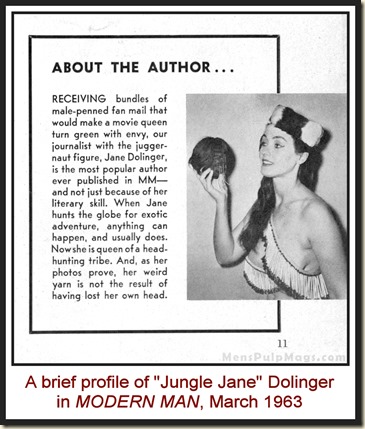 A story appeared in MODERN MAN, March 1963. Entitled, “Jungle Jane: QUEEN OF THE AMAZON,” the byline was Miss Dolinger herself. As an example of her thrilling and adventurous style of writing, following is the text as it appeared in the magazine:
A story appeared in MODERN MAN, March 1963. Entitled, “Jungle Jane: QUEEN OF THE AMAZON,” the byline was Miss Dolinger herself. As an example of her thrilling and adventurous style of writing, following is the text as it appeared in the magazine:
My name will not he found in Burke’s Peerage, but “Queen Jane” is known throughout the Amazon as the white girl who ruled a savage Indian tribe deep in the jungles of Ecuador. Admittedly, I will travel anywhere and do almost anything for a story but this is one adventure I had not planned and one I do not intend to repeat.
When I set out by Indian canoe on one of my many trips into the Ecuador interior, I had no intention of visiting the Machaqui tribe–but my guide followed the wrong river and I found myself in the territory of these dreaded head-hunters. It was getting too dark to turn back, so we set up camp for the night–without a fire. With the moon riding high across the cloud-flecked sky, I heard the pounding of Indian drums, and I knew that messages were being sent up and down the river to advise the witch doctors that our group was near their main village on the banks of the Rio Tiputini.
Early the next morning, we tried to slip away. But as we rounded a bend in the narrow river, we were intercepted by six canoes filled with painted Indians. They forced my canoe to the river bank and in Quechua, the native tongue of all Amazon tribes, told us bluntly that their brujo, or witch doctor, was expecting us.
Prodded by their lances, my guide and I hurried down a wide jungle trail. It was a mass of bright flowers, and overhead in the trees were dazzling pink, white, purple, and black orchids. Flitting through the branches were dozens of yellow and blue macaws, long-billed toucans, and flocks of shimmering green parrots.
It took two hours to reach the village–a dismal assortment of about 40 palm-thatched huts without walls. We were halted in front of one hut from which dangled a grisly shrunken head. From my experience in the Amazon, I knew that this was the sign of the brujo and that within the next few minutes he would decide my fate.
A gaudily painted young man–slender, lithe, and wiry–emerged from the hut and studied me with his dark eyes.
“Do you speak my language?” he asked in Quechua.
“Not too well,” I replied, “but enough, I hope.”
He scratched the back of his head, gave me the once-over, and then burst into a wide grin.
“Last night,” he said, “the drums warned that a woman was near our village, but I could not believe it. We have seen many missionaries, but you are the first white woman to come here…and now that you are here, I want to tell you that for many weeks I have dreamed about a white goddess who would come among us to be our queen.”
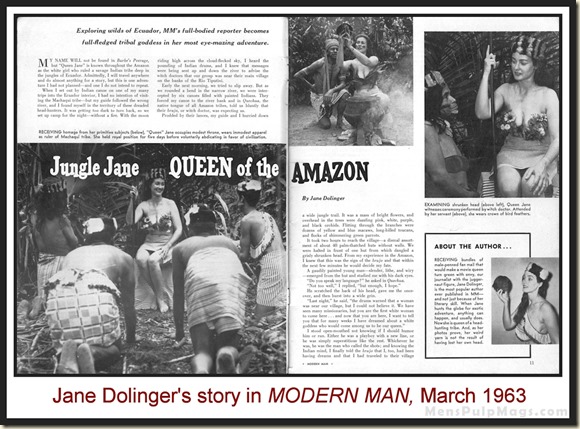 I stood open-mouthed not knowing if I should humor him or run. Either he was a playboy with a new line, or he was simply superstitious like the rest. Whichever he was, he was the man who called the shots; and knowing the Indian mind, I finally told the brujo that I, too, had been having dreams and that I had traveled to their village following a destiny over which I had no control. I could pour it on as thick as anyone, I thought, and this was exactly what the witch doctor wanted to hear. He nodded solemnly. Like all other tribes I had visited over the past few years, the lives of the Machaquis are steeped in superstition, and this which doctor was no different.
I stood open-mouthed not knowing if I should humor him or run. Either he was a playboy with a new line, or he was simply superstitious like the rest. Whichever he was, he was the man who called the shots; and knowing the Indian mind, I finally told the brujo that I, too, had been having dreams and that I had traveled to their village following a destiny over which I had no control. I could pour it on as thick as anyone, I thought, and this was exactly what the witch doctor wanted to hear. He nodded solemnly. Like all other tribes I had visited over the past few years, the lives of the Machaquis are steeped in superstition, and this which doctor was no different.
I looked up and studied the shrunken head which hung grotesquely from a rafter of the hut. Three long strings of jungle vine tied the mouth shut. Like the head-hunting Jivaros, the witch doctors of the Machaquis sewed together the lips of their victims to make certain that the spirits of the dead men could not escape to wreak vengeance upon those who had mutilated their bodies. Yes, the brujo was serious–deadly serious–and I had gotten myself involved, for better or worse, beyond the point of backing out.
After the witch doctor left, I was escorted by several Indian women to one of the huts where I was disrobed and clothed in the colorful garments of the tribe. But I made one concession to civilization. While most women were nude above the waist, I insisted on covering my bosom with garlands of flowers. Like all Machaqui women, my cheeks were painted with two red spots made from the juice of the achiote fruit.
The witch doctor, whose name was Sagino (meaning “wild boar”), was a man of action. That night, the drums pounded. And by noon of the next day, nearly 400 Indians had arrived to watch my coronation as “Queen of the Machaquis.”
My guide had been instructed in the use of my Rollei, and I put him to work photographing the procedure. This was not only a great moment in my life–one which I wanted to record on film–but also, I knew, the pictures would be necessary to prove it!
There were no white horses, no gilded carriage, and no triumphal procession. But even a transcontinental television hook-up would not have made me feel any more important as I walked along a trail to a throne of palm fronds. I was escorted to a small wooden bench draped in a piece of hand-woven material. The brujo appeared and put on my head a crown of multi-colored bird feathers.
I do not know what I expected, but I was pleased to learn that there was nothing more to the ceremony, and that I would not have to go out into the jungle and slay a jaguar or shrink someone’s head. I was a bona fide jungle queen, and my bird feathers were my authority.
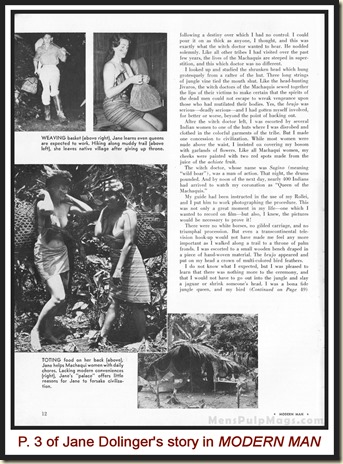 Each day after my coronation, I sat on the “throne” for an hour or two. I doled out to the women hair ribbons, mirrors, combs, cheap lipsticks, bobby-pins, and other trinkets which I always carry on my forays into the jungle. For the men, I had fish hooks and cigarettes, and for the chiefs, gleaming new machetes. In turn, the Indians brought me jungle fruits, colorful plumes of birds, neck laces made of monkey bones and jaguar teeth, and most important, golden nuggets wrapped in palm leaves. I learned later that some of the river beds in Ecuador are repositories for nuggets washed down the slopes of the Andes. The mother lode has never been found.
Each day after my coronation, I sat on the “throne” for an hour or two. I doled out to the women hair ribbons, mirrors, combs, cheap lipsticks, bobby-pins, and other trinkets which I always carry on my forays into the jungle. For the men, I had fish hooks and cigarettes, and for the chiefs, gleaming new machetes. In turn, the Indians brought me jungle fruits, colorful plumes of birds, neck laces made of monkey bones and jaguar teeth, and most important, golden nuggets wrapped in palm leaves. I learned later that some of the river beds in Ecuador are repositories for nuggets washed down the slopes of the Andes. The mother lode has never been found.
It was not all fun, however. The food we ate could scarcely be called a gastronomical delight. A typical dinner consisted of banana soup, boiled boa snake, fried fish (with entrails intact), sweet potatoes, toasted gusanos (grubworms), wild honey, and chicha—a vile and potent brew. To see this food prepared was enough to turn my stomach. Young boa snakes, six to eight feet long, were first decapitated. Their still-writhing bodies were then dumped into clay pots filled with boiling fat. After being cooked for about a half-hour, they were fished out, cut into small pieces, and served.
I might, however, have accumulated a fortune in gold nuggets had not sex reared its ugly (in this case) bead. On the fifth night of my rule, Sagino told me that all Machaquis had accepted me as their queen. They now wanted to make sure that there would be a successor. Sagino, as brujo, had been chosen by the chiefs to father my child.
Luckily, I had anticipated something like this when I first met Sagino, so I did not act alarmed. When a white woman lives with savage tribes, they invariably want to find her a suitable husband, because nothing is so unnatural to them as to have in their midst a childless woman.
I told Sagino I would be happy to comply with the wishes of his tribe. However, first there were certain acts which I had to perform alone in order to purify myself for the matrimonial couch. I clothed these acts in secrecy, claiming that they must be accomplished for the good of all the people of the tribe. I explained very carefully that early next morning I would leave in one of the canoes for a secret destination, there to make certain sacrifices, and bathe in the pure water of one of the many lakes in the vicinity. I would return within three days.
I also told Sagino that my guide, who served as my personal servant, would accompany me for my own protection.
When Sagino agreed, I breathed again. He even promised that as a wedding gift, he would give me a pocketbook made of monkey fur, twenty parrots, and a new hut.
I almost regretted having to deceive the Machaquis, but I also knew what life would be like among them. My short-wrap-around skirt and flowered brassiere were hardly sufficient to protect my body from the bites of swarming, tiny black flies who bit harder than mosquitos and left scars that often remained for a year. The huts were always filled with clouds of smoke, and we slept on bamboo slats without covers and in the same clothes we had worn each day. Then, there was the food. I decided that jungle life could never compare with Paris or London.
Next morning, while the village was still asleep, I quietly hurried into my slacks, blouse, and jungle boots and followed the trail leading to the river. My guide was waiting for me in the canoe. We hurriedly paddled upstream in the direction of Puerto Napo, expecting at any time to hear the drums signaling natives to stop us. But the drums never sounded.
It had been a thrilling experience, but five days as “Queen of the Machaquis” had been more than enough.
Sagino did not know it, but I had abdicated my throne.
* * * * * *
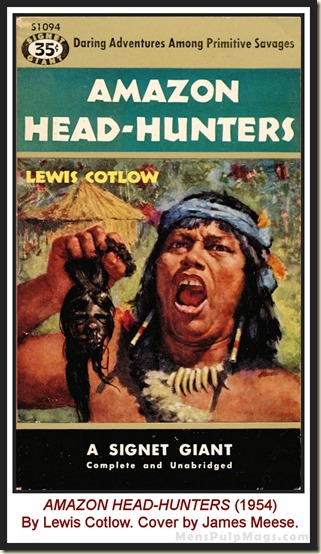 So, what exactly were these “tsantsas”, these shrunken heads, and how exactly were they made?
So, what exactly were these “tsantsas”, these shrunken heads, and how exactly were they made?
These questions would be easily answered for anyone in 1954 that were curious enough to shell out 35-cents for Lewis Cotlow’s Signet paperback, AMAZON HEAD-HUNTERS, off the drug store spinner rack. Cotlow had observed first-hand the practice of head-hunting and subsequent head shrinking by the Shuar tribes indigenous to Ecuador and parts of Peru.
They were known by early European explorers as the Jivaro, but this term has in recent years been less used, as it is considered today to be derogatory, meaning “savage” or “uncivilized”. Historically, the Shuar are noted as being the only ethnic South Americans to successfully resist the Spanish conquistadores. As one might imagine, head hunting, and the resulting ritual of shrinking, has left a considerably larger impression on popular culture. Cotlow, an author, explorer and filmmaker, and who was quite well-known in his day, describes the process:
Asapi took a sharp bamboo knife from his monkey-fur pouch and parted the hair of the enemy wishinu carefully up the back. Then he cut through the scalp neatly, from the bottom of the bloody neck to the top of the skull. Next he very carefully peeled back the skin, away from the skull, using the bamboo knife where necessary to free the flesh from the bone. In fifteen minutes he had removed the skin from the skull, which he tossed aside. With the skin inside out, Asapi then sewed the eyelids shut from the inside, after which he turned the skin right side out once more.
From his pouch the tired but happy curaka took three short, pointed pins of chonta wood which he thrust through the lips. He wound long chambira fibers around the pins to make certain the lips remained shut.
He then went to a jar of water that had been placed over a fire. Into it he dropped the juice of a vine that he knew would keep the hair from falling from his tsantsa. Holding the head by the end of the hair, he lowered it into the water. While the head cooked, Asapi went to the water’s edge looking for stones, round stones of certain sizes. As he found two or three he returned to the fire and put them in the ashes to become hot. He lifted the head from the water to see how it was coming along and noted with satisfaction that it had already begun to grow smaller.
Asapi had to wander far up and down the stream to find enough of the stones he wanted, for there were eight other warriors going through the same process and all searched for stones. The boys who had come along helped, of course, and watched closely every operation performed by the fighters.
After about two hours of boiling the head was about a third of the size it had been originally, and with a smile of satisfaction, Asapi took it from the pot of water, holding it by the hair and waving it so it would cool off enough for him to handle it. It did not look a great deal like a human face, for many of the features were out of shape and the skin was a dirty yellow. But Asapi knew he could take care of those things. He had done all this many times before.
Holding the head in his left hand he made holes with a chonta pin along the sides of the incision, then neatly seed it together with fiber. He now had a kind of hollow sack that had only a few hours before been scowling at him and hurling insults at him. With a forked stick, Asapi reached into the fire and found a round stone that would just fit into the neck opening of his tsantsa. As he dropped it in there was a loud sizzling and a cloud of steam arose. Holding the head in both hands he rotated it rapidly so that the hot stone rolled around inside, searing away all loose flesh and drying out the skin.
When the sizzling stopped that meant the stone was cool, so Asapi dumped it out and chose another hot stone, this one a little smaller, for the head had shrunk a bit more.
During the second whirling, Asapi took up a small unheated stone with a smooth flat surface and began to rub it over the outside of the face, pushing here, pressing there to form the features as they should be. So with stone after stone he seared the inside of the head, the heat shrinking it more all the time. And he shaped the features carefully, plucking eyebrows and eyelashes occasionally but being careful not to burn them or pull too many out,. There must be just enough to look in proportion to the small head.
Finally, Asapi scooped up hot sand from under the fire and poured it into the head. He whirled it vigorously, poured it out when it had cooled, put more hot sand in. The hot sand reached every crack in the inside of the tsantsa, drying and shrinking it. When Asapi concluded that the process had gone far enough, he bound the neck opening with fiber, poked a hole through the top of the head, and pushed a long cord of fiber through it, doubled over a pin to hold it inside. Then he struck his lance into the sand at an angle, hung the tsantsa in the smoke over the fire, and lay down to contemplate his handiwork.”
[EDITOR’S NOTE: In 2011, Heritage Auctions sold this original painting by James Meese and IDed it as the cover art for the 1954 edition of the book AMAZON HEAD-HUNTERS. However, the painting is clearly different from the one on that 1954 book cover. Why it’s different is a mystery. If anyone knows, please let me know.]
* * * * * *
It’s hard to pinpoint exactly when shrunken heads began to be sold as pop culture novelty items, but sometime around the mid-1950’s ads for them began to appear in magazines, especially in the men’s sweats.
They were even seen for sale along with Venus Fly Traps and “Sea Monkeys” in the pages of kids’ comic books! Later, they were frequently found as an item for sale in the mail order pages of monster film magazines such as FAMOUS MONSTERS OF FILMLAND, MAD MONSTERS and HORROR MONSTERS.
Shrunken heads had been offered for sale as curios as far back as the mid to late 1800’s after tales of the strange objects were brought back from exploration of the Ecuadorian and Peruvian regions.
A surge of counterfeit tsantsas followed, and they began flooding European markets in the early 1900’s.
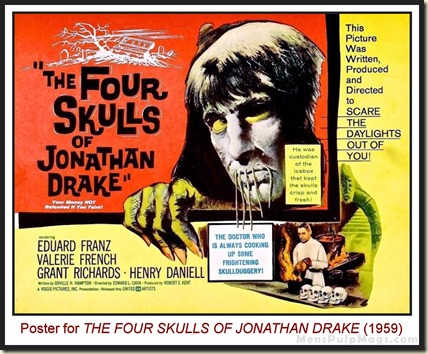 Early imitations were made with both human and non-human materials.
Early imitations were made with both human and non-human materials.
Human materials were acquired through the convenient but nefarious practice of unclaimed hospital dead, grave robbing and stealing from morgues (!).
One can easily imagine a South American version of Dr. Frankenstein or Burke and Hare! Non-human materials that were used were from goat or monkey skins. Today’s replica shrunken heads are made usually from goat skins and alpaca hair.
In 1959, during what might have been the height of the shrunken head phenomenon, a horror film hit the drive-ins that epitomized all the popularized notions of tsantsas.
Released by United Artists, THE FOUR SKULLS OF JONATHAN DRAKE starred Eduard Franz, Valerie French and Henry Daniell.
Paul Wexler played a living, walking embodiment of a tsantsa, complete with his lips sewn shut!
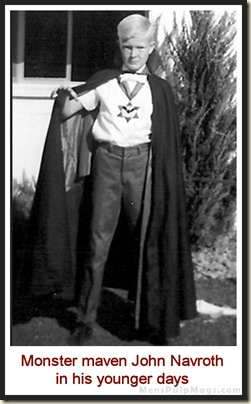 Directed by Edward L. Cahn from a script by Orville Hampton, the film’s highlight was a sequence where the audience is treated to a scene of the mad Dr. Emil Zurich (Daniell) going through the largely historically accurate process (albeit accelerated for the movie) of shrinking a head in his cramped basement laboratory.
Directed by Edward L. Cahn from a script by Orville Hampton, the film’s highlight was a sequence where the audience is treated to a scene of the mad Dr. Emil Zurich (Daniell) going through the largely historically accurate process (albeit accelerated for the movie) of shrinking a head in his cramped basement laboratory.
Amazing accuracy coming from a B-movie!
The realistic shrunken head props were designed and created by make-up man Charles Gemora, who had up until then, played the “man in the ape suit” in many low budget horror and comedy films.
The shrunken head market remained a staple of many novelty, joke and magic catalogues throughout the 1960’s.
As mentioned, they could be seen advertised within the pages of various monster film magazines of the period as well, with pronouncements such as “The Most Genuine Looking Shrunken Head Ever Made!”, “Looks absolutely real!”, and “Gives your den or ‘rumpus room’ that lived in look!”
Ads for shrunken heads were still seen into the early 1970’s.
But, as with every other craze, fan phase, and swag du jour, the fad just started to fizzle out.
Even today, you can still see shrunken heads for sale here and there (for instance, Seattle’s world-famous waterfront Ye Old Curiosity Shop has life-like replicas made from goat skin) and they remain on display as curiosities at Ripley’s Odditoriums around the country.
The market may have “shrunk”, but tsantsas will always be indelible as icons of one crazy pop culture phenomenon!
* * * * * *
EDITORS NOTE: Thanks again to John Navroth for this terrific guest post and his past reviews of books in our Men’s Adventure Library series! I look forward every day to your posts on your MONSTER MAGAZINE WORLD site, John. Cheers!
* * * * * * * * * *
Comments? Corrections? Post them on the Weasels Ripped My Book Facebook Page, email them to me,
or join the Men’s Adventure Magazines & Books Facebook Group and post them there.
Related reading and viewing…


